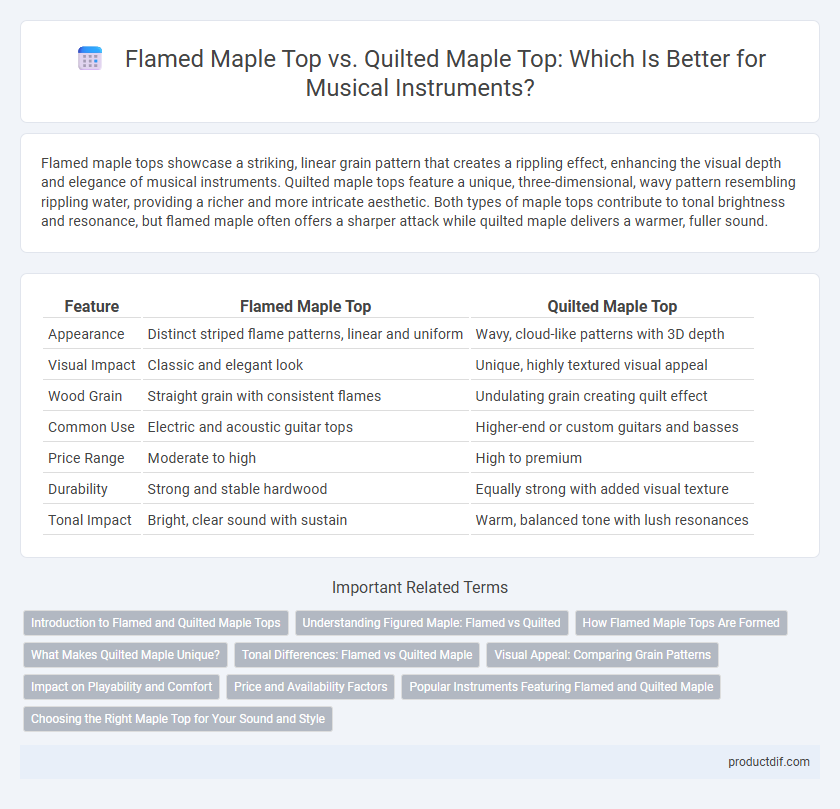Flamed maple tops showcase a striking, linear grain pattern that creates a rippling effect, enhancing the visual depth and elegance of musical instruments. Quilted maple tops feature a unique, three-dimensional, wavy pattern resembling rippling water, providing a richer and more intricate aesthetic. Both types of maple tops contribute to tonal brightness and resonance, but flamed maple often offers a sharper attack while quilted maple delivers a warmer, fuller sound.
Table of Comparison
| Feature | Flamed Maple Top | Quilted Maple Top |
|---|---|---|
| Appearance | Distinct striped flame patterns, linear and uniform | Wavy, cloud-like patterns with 3D depth |
| Visual Impact | Classic and elegant look | Unique, highly textured visual appeal |
| Wood Grain | Straight grain with consistent flames | Undulating grain creating quilt effect |
| Common Use | Electric and acoustic guitar tops | Higher-end or custom guitars and basses |
| Price Range | Moderate to high | High to premium |
| Durability | Strong and stable hardwood | Equally strong with added visual texture |
| Tonal Impact | Bright, clear sound with sustain | Warm, balanced tone with lush resonances |
Introduction to Flamed and Quilted Maple Tops
Flamed maple tops feature a distinctive tiger-stripe pattern caused by the wood grain's undulating figure, enhancing the visual depth and brilliance of musical instruments like guitars and violins. Quilted maple tops showcase a three-dimensional, rippled pattern resembling ocean waves, prized for its unique and intricate texture that adds aesthetic value to string instruments. Both types of maple tops are favored for their tonal qualities, durability, and stunning appearance, significantly influencing the instrument's overall sound and visual appeal.
Understanding Figured Maple: Flamed vs Quilted
Flamed maple tops display a striking linear, flame-like pattern that enhances the guitar's bright tonal clarity and visual depth, making it a popular choice for players seeking both aesthetic and acoustic excellence. Quilted maple tops exhibit a three-dimensional, wavy, and almost water-like texture that produces a richer, warmer resonance with a unique look favored in higher-end instruments. Understanding the distinct grain patterns of flamed versus quilted maple helps musicians and luthiers select the optimal figure for tonal preference and visual impact.
How Flamed Maple Tops Are Formed
Flamed maple tops are created through the natural growth patterns of the sugar maple tree, where tight, parallel lines of varying grain density produce a distinctive "flame" or ripple effect. This optical illusion originates from the wood fibers reflecting light differently, enhancing the instrument's aesthetic appeal and depth. The precision in selecting and cutting the wood emphasizes these unique patterns, making flamed maple tops highly sought-after for guitars and other stringed instruments.
What Makes Quilted Maple Unique?
Quilted maple tops stand out due to their distinctive, three-dimensional wavy grain pattern that creates a visually striking effect resembling rippling water or a quilted fabric. This unique grain structure results from irregular growth patterns in the maple wood, enhancing both the aesthetic appeal and the tonal complexity of musical instruments. Compared to flamed maple, which features straighter, flame-like patterns, quilted maple provides a more elaborate figure that is highly sought after for high-end guitars, violins, and other stringed instruments.
Tonal Differences: Flamed vs Quilted Maple
Flamed maple tops deliver a bright, articulate tone with pronounced high-end clarity and sustain, enhancing the guitar's overall presence in a mix. Quilted maple tops offer a warmer, richer sound characterized by enhanced midrange complexity and a smoother tonal response. These tonal differences stem from the unique grain patterns influencing vibration and resonance in each maple type.
Visual Appeal: Comparing Grain Patterns
Flamed maple tops showcase a distinctive, linear grain pattern with a shimmering, ribbon-like effect that enhances the instrument's elegance and depth. Quilted maple tops feature a more dynamic, three-dimensional wavy grain resembling ripples or bubbles, creating a visually striking, textured surface. Both grain patterns significantly elevate the aesthetic appeal of guitars and violins, with flamed maple offering a classic, refined look and quilted maple providing a bold, artistic appearance.
Impact on Playability and Comfort
Flamed maple tops offer a dense grain structure that enhances the instrument's sustain and resonance, contributing to a more responsive playing experience. Quilted maple tops provide a slightly softer feel under the fingers, improving comfort during extended play sessions due to their typically lighter weight. Both wood types influence tonal brightness and warmth, but the flamed maple top often delivers more clarity, while the quilted maple top emphasizes a smoother, more balanced sound.
Price and Availability Factors
Flamed maple tops are generally more affordable and widely available than quilted maple tops, making them a popular choice among guitar manufacturers. Quilted maple tops, characterized by their distinctive, wavy grain patterns, demand a higher price due to their rarity and complex harvesting process. Availability of quilted maple is limited, often leading to longer wait times and increased cost for custom instruments.
Popular Instruments Featuring Flamed and Quilted Maple
Popular instruments featuring flamed maple tops include electric guitars like the Gibson Les Paul and PRS Custom 24, prized for their striking visual grain and bright tonal qualities. Quilted maple tops are commonly found on high-end instruments such as the Ibanez JEM and Suhr Modern, valued for their rich, three-dimensional patterns and enhanced sustain. Both types of maple tops are favored by professional musicians for their combination of aesthetic appeal and tonal clarity.
Choosing the Right Maple Top for Your Sound and Style
Flamed maple tops offer a bright, articulate tone with a visually striking, linear grain pattern that enhances clarity and definition, making them ideal for genres requiring crisp, cutting sounds. Quilted maple tops display a more complex, wavy grain pattern, contributing to a warmer, richer tonal character favored in blues, jazz, and rock for their depth and textural warmth. Selecting between flamed and quilted maple depends on your desired sound profile and aesthetic preference, balancing tonal brightness against a visually dynamic, textured look.
Flamed maple top vs Quilted maple top Infographic

 productdif.com
productdif.com